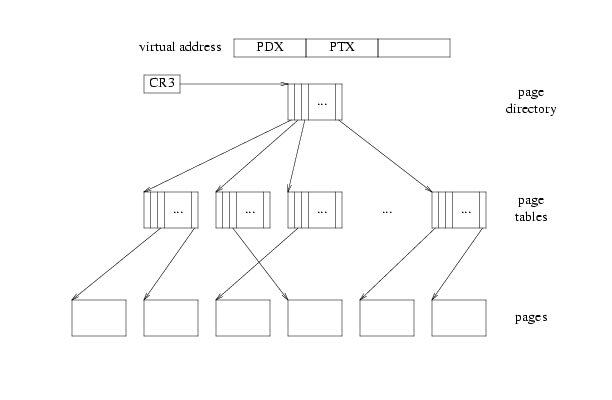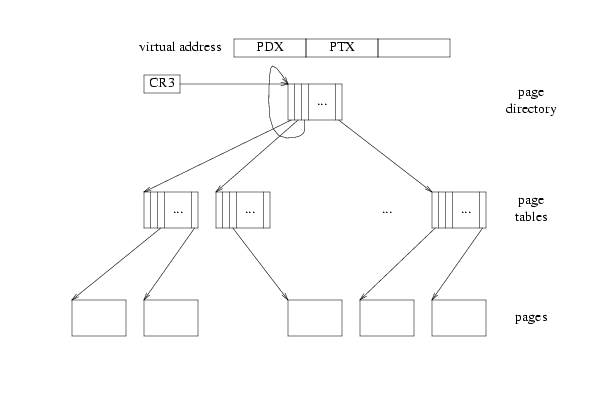
Reading: 80386 chapters 5 and 6
Handout: x86 address translation diagram -
PDF -
PS -
EPS -
xfig
Why do we care about x86 address translation?
Why aren't protected-mode segments enough?
Translation using page tables on x86:
uint
translate (uint la, bool user, bool write)
{
uint pde;
pde = read_mem (%CR3 + 4*(la >> 22));
access (pde, user, read);
pte = read_mem ( (pde & 0xfffff000) + 4*((la >> 12) & 0x3ff));
access (pte, user, read);
return (pte & 0xfffff000) + (la & 0xfff);
}
// check protection. pxe is a pte or pde.
// user is true if CPL==3
void
access (uint pxe, bool user, bool write)
{
if (!(pxe & PG_P)
=> page fault -- page not present
if (!(pxe & PG_U) && user)
=> page fault -- not access for user
if (write && !(pxe & PG_W))
if (user)
=> page fault -- not writable
else if (!(pxe & PG_U))
=> page fault -- not writable
else if (%CR0 & CR0_WP)
=> page fault -- not writable
}
How we will use paging (and segments) in JOS:
4 Gig --------> +------------------------------+
| | RW/--
~~~~~~~~~~~~~~~~~~~~~~~~~~~~~~~~
: . :
: . :
: . :
|~~~~~~~~~~~~~~~~~~~~~~~~~~~~~~| RW/--
| | RW/--
| Remapped Physical Memory | RW/--
| | RW/--
KERNBASE -----> +------------------------------+ 0xf0000000
| Cur. Page Table (Kern. RW) | RW/-- PTSIZE
VPT,KSTACKTOP--> +------------------------------+ 0xefc00000 --+
| Kernel Stack | RW/-- KSTKSIZE |
| - - - - - - - - - - - - - - -| PTSIZE
| Invalid Memory | --/-- |
ULIM ------> +------------------------------+ 0xef800000 --+
| Cur. Page Table (User R-) | R-/R- PTSIZE
UVPT ----> +------------------------------+ 0xef400000
| RO PAGES | R-/R- PTSIZE
UPAGES ----> +------------------------------+ 0xef000000
| RO ENVS | R-/R- PTSIZE
UTOP,UENVS ------> +------------------------------+ 0xeec00000
UXSTACKTOP -/ | User Exception Stack | RW/RW PGSIZE
+------------------------------+ 0xeebff000
| Empty Memory | --/-- PGSIZE
USTACKTOP ---> +------------------------------+ 0xeebfe000
| Normal User Stack | RW/RW PGSIZE
+------------------------------+ 0xeebfd000
| |
| |
~~~~~~~~~~~~~~~~~~~~~~~~~~~~~~~~
. .
. .
. .
|~~~~~~~~~~~~~~~~~~~~~~~~~~~~~~|
| Program Data & Heap |
UTEXT --------> +------------------------------+ 0x00800000
PFTEMP -------> | Empty Memory | PTSIZE
| |
UTEMP --------> +------------------------------+ 0x00400000
| Empty Memory | PTSIZE
0 ------------> +------------------------------+
Remember how the X86 translates virtual addresses into physical ones:

CR3 points at the page directory. The PDX part of the address indexes into the page directory to give you a page table. The PTX part indexes into the page table to give you a page, and then you add the low bits in.
But the processor has no concept of page directories, page tables, and pages being anything other than plain memory. So there's nothing that says a particular page in memory can't serve as two or three of these at once. The processor just follows pointers: pd = lcr3(); pt = *(pd+4*PDX); page = *(pt+4*PTX);
Diagramatically, it starts at CR3, follows three arrows, and then stops.
If we put a pointer into the page directory that points back to itself at index Z, as in

then when we try to translate a virtual address with PDX and PTX equal to V, following three arrows leaves us at the page directory. So that virtual page translates to the page holding the page directory. In Jos, V is 0x3BD, so the virtual address of the VPD is (0x3BD<<22)|(0x3BD<<12).
Now, if we try to translate a virtual address with PDX = V but an arbitrary PTX != V, then following three arrows from CR3 ends one level up from usual (instead of two as in the last case), which is to say in the page tables. So the set of virtual pages with PDX=V form a 4MB region whose page contents, as far as the processor is concerned, are the page tables themselves. In Jos, V is 0x3BD so the virtual address of the VPT is (0x3BD<<22).
So because of the "no-op" arrow we've cleverly inserted into the page directory, we've mapped the pages being used as the page directory and page table (which are normally virtually invisible) into the virtual address space.